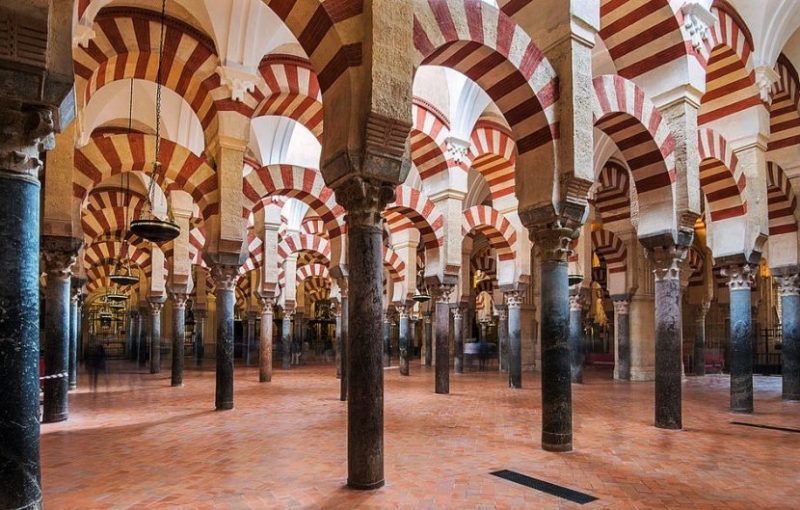
Córdoba is not one of Spain’s largest cities, and does not receive enough publicity. During my recent visit to the country, however, Córdoba proved to be a wonderful combination of historical interest, beauty, and idiosyncratic life.
More so than the metropolises of Madrid and Barcelona, Córdoba is an oasis of pleasure without big city congestion. Those cities are enjoyable, mind you, but any visitor to Spain should make a point to see Córdoba for its special charm. Spend at least two nights. It will be worth your while.
The city of 300,000 is 150 miles north of Gibraltar and the Mediterranean Sea. Córdoba’s climate is warm; palms and orange trees are visible on almost every street. While Toledo and Segovia, in the middle of the country, have steep hills, Córdoba is relatively flat and is easy to walk around. Seville and Granada are nearby and can be included in an extension of your trip.
The architecture of Córdoba is the product of Muslim caliphs who ruled for centuries and were tolerant of Jews and Christians, and we see buildings that combine designs of all three cultures.
The city’s most prominent landmark is the Mezquita, a beautiful building that symbolizes the religious changes which Córdoba underwent. It was the largest mosque in the world, although now a Catholic house of worship. Built in the 8th century, the Mezquita displays stunning Islamic architecture and decoration. Interior columns incorporate materials sent from various provinces of Iberia, including gold, silver, copper, ivory, jasper, and scented woods. The vistas of decorated pillars resemble rows of palm trees. Among these columns are ornately decorated altars.
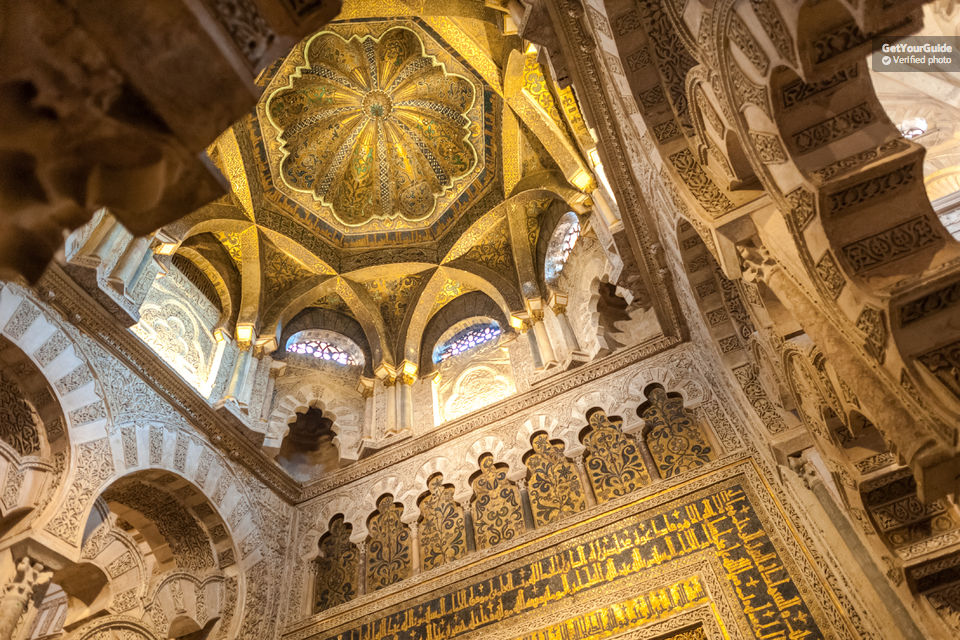 A few steps away is the Alcázar de los Reyes Cristianos, an imposing set of buildings with Gothic walls and towers. Outside are lovely gardens and pools. King Ferdinand and Queen Isabella governed from the Alcázar in the 15th century and here the queen listened to Christopher Columbus’s proposal to lead his journey to the Americas. The Alcázar also was one of the first tribunals of the Spanish Inquisition.
A few steps away is the Alcázar de los Reyes Cristianos, an imposing set of buildings with Gothic walls and towers. Outside are lovely gardens and pools. King Ferdinand and Queen Isabella governed from the Alcázar in the 15th century and here the queen listened to Christopher Columbus’s proposal to lead his journey to the Americas. The Alcázar also was one of the first tribunals of the Spanish Inquisition.
Grand monumental gates survive, which were part of the city’s walls in Medieval times, with fluted columns and curved pediments. The Seville Gate was the landmark from which travelers left to journey south, attached at right angles to the city wall, with a square watchtower on the end. A 15th-century tower called la Malmuerta (“she who has died badly”) is named in memory of a Cordoban lady killed by her jealous husband, similar to the story of the opera Written on Skin.
The ideal place to stay is Las Casas de la Judería de Córdoba, a boutique hotel with history. The rooms of this charming hotel are in clusters 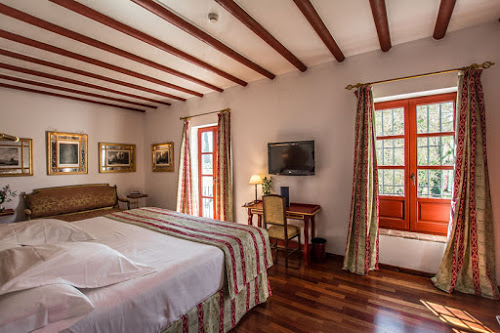 around tranquil courtyards with fountains and gardens. Archaelogical remains within the hotel date back to the Roman Empire. Its doors face the Jewish Quarter, very close to the Mezquita, Alcázar and other places of interest. Admission to these sites is free during morning hours, which gives a great advantage to visitors staying overnight here. The hostelry is elegant and charming, and our room had a huge bed and all modern conveniences although the style is classical Spanish. (www.lascasasdelajuderiadecordoba.com/)
around tranquil courtyards with fountains and gardens. Archaelogical remains within the hotel date back to the Roman Empire. Its doors face the Jewish Quarter, very close to the Mezquita, Alcázar and other places of interest. Admission to these sites is free during morning hours, which gives a great advantage to visitors staying overnight here. The hostelry is elegant and charming, and our room had a huge bed and all modern conveniences although the style is classical Spanish. (www.lascasasdelajuderiadecordoba.com/)
During the Moorish era, Córdoba was famed for having an educated population, with prestigious doctors and philosophers, including Moses ben Maimon, known as Maimonides. He was a Sephardic Jewish physician who became a rabbi and one of the most influential scholars of the Middle Ages. His birthplace in Córdoba is marked with a seated statue of him.
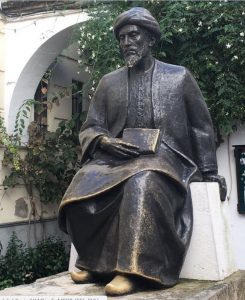 After their temple in Jerusalem was destroyed in 70 A.D., many Jews moved to Spain and Córdoba became the largest Jewish community in Europe. The Jewish Quarter is the most picturesque neighborhood in Córdoba, with narrow, twisting streets surrounded by colorful patios and gardens. One synagogue from those times survives, with floral designs in the Mudejar style. Mudejars were Muslims during the Christian conquest of the Iberian peninsula who were allowed to retain Islamic laws and religion in return for loyalty to a Christian monarch.
After their temple in Jerusalem was destroyed in 70 A.D., many Jews moved to Spain and Córdoba became the largest Jewish community in Europe. The Jewish Quarter is the most picturesque neighborhood in Córdoba, with narrow, twisting streets surrounded by colorful patios and gardens. One synagogue from those times survives, with floral designs in the Mudejar style. Mudejars were Muslims during the Christian conquest of the Iberian peninsula who were allowed to retain Islamic laws and religion in return for loyalty to a Christian monarch.
Strolling through these streets on a sunny day is sheer joy. Colorful flower pots and wrought-iron window grilles adorn almost every building. Every conceivable type of eatery beckons, from casual snacks to gourmet meals. Some restaurants have resident guitarists. One of my best meals in Spain was at Casa Pepe de la Juderia. The name refers to the neighborhood, not to the cuisine, which is traditional Spanish. Local specialties include berenjenas (fried eggplant with honey) and salmorejo Córdobes (a delicious cold tomato soup, creamier than gazpacho).
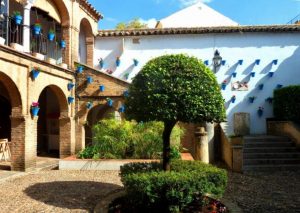 Next door to our hotel is a Caliphal bath, with labyrinthian grottos. The walls of the rooms are solid stone blocks and the vaulted ceilings have star-shaped openings, supported by semi-circular arches of marble. Nearby, the remains of a Roman temple are dominated by nine tall Corinthian columns. The Palacio de Viana is a huge private palace that was recently converted to a public museum. The building and gardens have tapestries from Flanders, artwork by Goya, and collections of porcelain, jewelry, firearms and musical instruments.
Next door to our hotel is a Caliphal bath, with labyrinthian grottos. The walls of the rooms are solid stone blocks and the vaulted ceilings have star-shaped openings, supported by semi-circular arches of marble. Nearby, the remains of a Roman temple are dominated by nine tall Corinthian columns. The Palacio de Viana is a huge private palace that was recently converted to a public museum. The building and gardens have tapestries from Flanders, artwork by Goya, and collections of porcelain, jewelry, firearms and musical instruments.
Comparing Córdoba to other cities, I recommend it as a relaxing, hospitable locale with history and contemporary lifestyle existing alongside each other in close proximity.